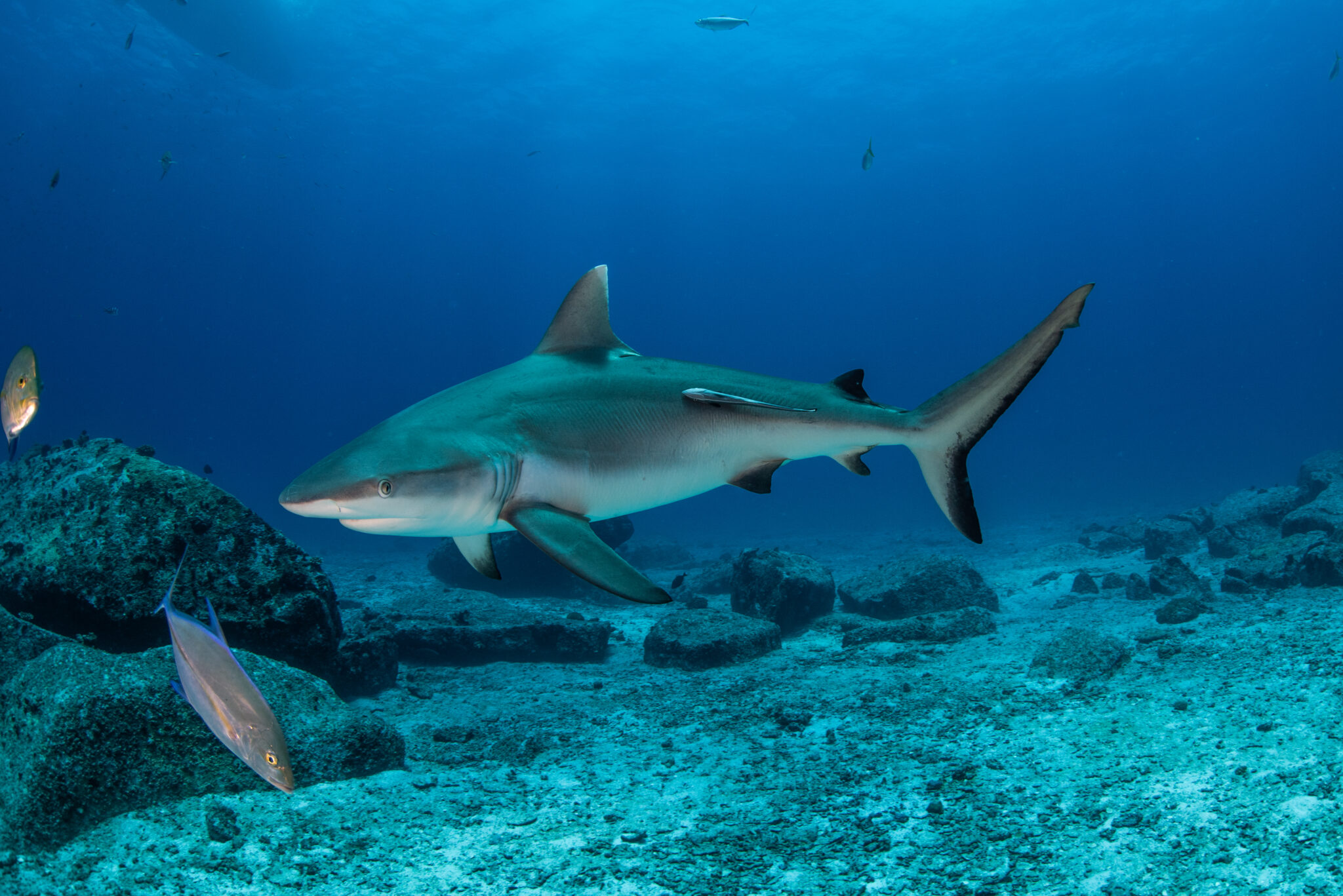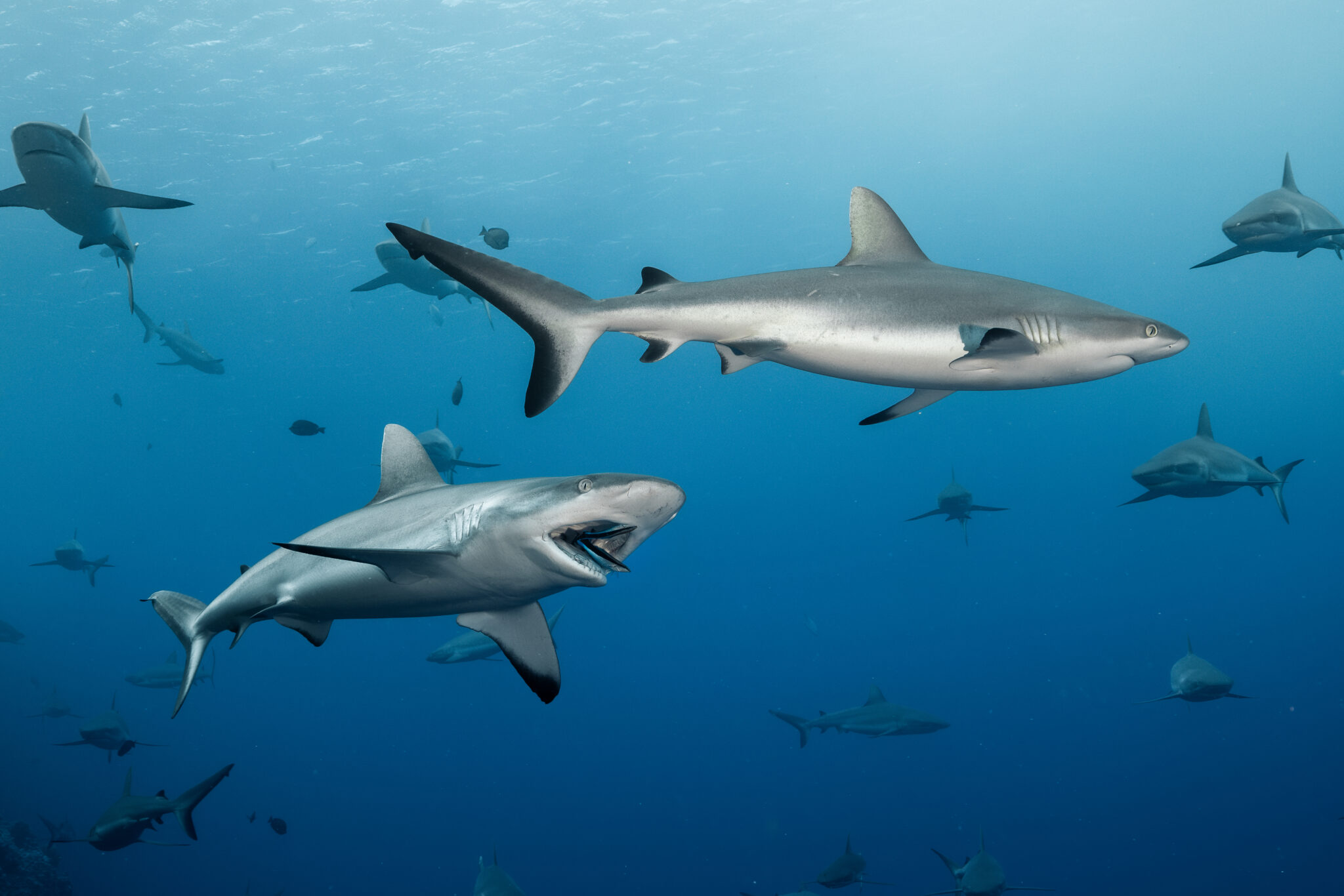Grey reef shark
Carcharhinus amblyrhynchos



A member of the requiem shark family, the grey reef shark is ‘classically shaped’ – slender, streamlined and built for an active lifestyle. They are social, aggregating during the day before breaking up at night to hunt alone on the reef.
IDENTIFICATION
Broad, rounded snout. Teeth serrated and narrow. Dark grey upper body with pale underside. Characteristic black margin on trailing edge of caudal fin, and black tips on the other fins. In some populations (Western Indian Ocean and Red Sea), the first dorsal is edged with white, and has therefore been described by some scientists as a distinct species, Carcharhinus wheeleri.

SPECIAL BEHAVIOUR
Grey reef sharks gather in groups during the day, where they will reside in reef passes and shallow lagoons. At night, these groups disperse as the sharks descend onto the reef itself to hunt.
REPRODUCTION
Grey reef sharks are viviparous with a yolk-sac placenta. They have a gestation period of around 12 to 14 months, after which the female will give birth to 1 to 6 live pups. Their reproductive cycle occurs every two years.
HABITAT AND GEOGRAPHICAL RANGE
Grey reef sharks are found in clear, tropical waters and are common around reefs, particularly near drop-offs, occurring from the surface to depths of 280 metres. They are found on continental and insular shelf waters, and are widespread in the Indo-West and Central Pacific Oceans, with patchier distributions in the Eastern Tropical Pacific.

DIET DESCRIPTION
Grey reef sharks feed on small reef fishes, crustaceans, squid and octopus.
THREATS
Unmanaged fisheries for grey reef sharks occur throughout its range. It is retained for its meat, fins, liver and skin. The fins occur in relatively small amounts in international trade. It is also a popular species in aquaria, and is exported from Australia and Indonesia for this purpose. Given its association with coral reef habitat, the grey reef shark is also vulnerable to climate change, poor water quality and destructive fishing practices, such as blast fishing and cyanide fishing.
RELATIONSHIP WITH HUMANS
Grey reef sharks are naturally inquisitive and will investigate divers. They can be aggressive, especially if food is present, but generally are considered safe to dive with as long as precautions are taken.
CONSERVATION
The grey reef shark is quite a valuable species to dive tourism and, as such, fishing is regulated in some places such as Queensland, Australia. Marine Protected Areas (MPAs) are also common to conserve coral reef habitats, and by association the grey reef shark is protected by general management measures. Similarly, grey reef sharks benefit from shark sanctuaries in some parts of their range, where targeted shark fishing is banned to promote recovery.
FUN FACTS
An individual grey reef shark tagged in the Coral Sea undertook a staggering 250-kilometre round trip just to visit the Great Barrier Reef.
Grey reef sharks put on displays when threatened. They arch their back, lower their pectoral fins and ‘wag’ their head and tail. If they feel especially put out, a grey reef shark will engage in spiral swimming and even figure-of-eight loops.
References
IUCN Red List of Threatened Species. 2019. Grey reef shark.
David A. Ebert et al. 2021. Sharks of the World: A Complete Guide.
Florida Museum. Discover fishes: Carcharhinus amblyrhynchos
Heupel, M.R., Simpfendorfer, C.A. and Fitzpatrick, R., 2010. Large–scale movement and reef fidelity of grey reef sharks. PloS one, 5(3), p.e9650.









